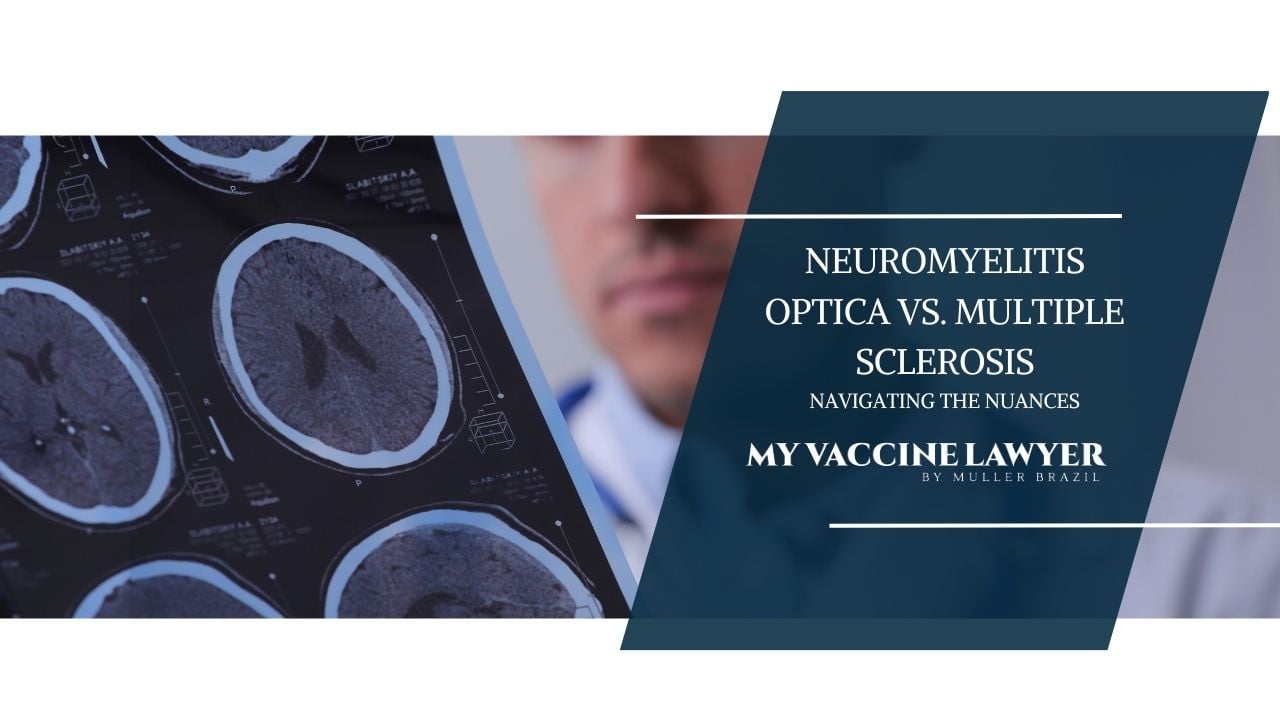NMO Disease Life Expectancy: Key Factors and Insights
Understanding the factors influencing life expectancy for those with this Neuromyelitis Optica (NMO) is essential in providing the best possible care...
8 min read
Vaccine Injury Law Resources / Neuromyelitis Optica / Neuromyelitis Optica vs MS: Key Differences Explained
 Max Muller
:
Feb 22, 2024 5:42:00 PM
Max Muller
:
Feb 22, 2024 5:42:00 PM
Recent studies show that 10-15% of those initially diagnosed with Multiple Sclerosis (MS) are later found to have Neuromyelitis Optica Spectrum Disorder (NMOSD). Both NMOSD and MS are autoimmune diseases affecting the nervous system, but they impact it differently.
NMOSD primarily harms the optic nerves and spinal cord, causing rapid and severe symptoms, whereas MS affects the brain and spinal cord more generally, with varying symptom progression.
Correct diagnosis is important because each condition requires different treatments: NMOSD often requires immune-suppressing drugs, while MS treatments focus on slowing the disease and managing symptoms. Diagnosis involves MRI scans, OCT scans, and specific antibody tests to ensure the right treatment and prevent symptom worsening. This understanding helps guide patients and healthcare providers in distinguishing between NMOSD and MS effectively.
NMOSD and MS, while sharing a common denominator of affecting the central nervous system, have distinct features that set them apart. Their differential diagnosis is a puzzle for clinicians, given their shared and unique characteristics.
We will decipher this puzzle by examining each of these conditions more intricately.
Neuromyelitis optica spectrum disorders (NMOSD) are mysteries in the field of neurological disorders. They primarily target the optic nerves, spinal cord, and sometimes the brain, resulting in sudden vision loss and paralysis. The autoimmune nature of NMOSD leads to attacks on healthy tissues, causing spinal cord involvement and optic nerve damage.
Despite its rarity, NMOSD presents a significant global burden, occurring more frequently in specific racial groups.

On the other hand, MS, another autoimmune disorder, wreaks havoc on the central nervous system in a different manner. MS attacks the protective covering of the nerves, disrupting the flow of information within the central nervous system. The disease duration varies widely among individuals, affecting:
The diagnosis, based on international consensus diagnostic criteria, involves the identification of damage in at least two distinct areas of the central nervous system and evidence that the damage occurred at different time points.
While the exact triggers of Neuromyelitis Optica Spectrum Disorder (NMOSD) and Multiple Sclerosis (MS) remain elusive, research suggests that a combination of genetic predisposition and environmental factors play a role. These environmental factors can include viral infections, vitamin D deficiency, and, in rare cases, vaccines.
Although vaccines are designed to protect against disease, they can, in a small number of individuals, trigger an immune response that may lead to autoimmune disorders like NMOSD and MS.
Distinguishing NMOSD from MS involves a labyrinth of diagnostic tools and techniques. From the intricate imagery of MRI to the precision of OCT to the specificity of antibody blood tests, each contributes a piece to the puzzle.
We will scrutinize these diagnostic tools and techniques to understand their role in differentiating NMOSD from MS better.
MRI, including brain MRI, is important in the diagnosis of NMOSD and MS, offering a visual guide into the depths of the nervous system. In NMOSD, MRI assists in identifying focal degeneration of the thalamus and optic radiation, with longitudinally extensive transverse myelitis being a key imaging factor.
On the other hand, in MS patients, brain MRI lesions reveal brain lesions surrounding the central venule in a majority of cases. Optic nerve lesions in NMOSD and most spinal cord lesions situated in the periphery are distinctive characteristics that help distinguish NMOSD from MS.
OCT provides another lens to view and differentiate NMOSD and MS. OCT is vital in assessing retinal damage. For NMOSD, OCT identifies damage to the afferent visual system resulting from optic neuritis and potentially recognizes NMOSD-specific intraretinal pathology.
For MS, OCT evaluates damage to the retina, specifically the optic nerve axons. The more severe retinal nerve fiber layer atrophy in NMOSD, indicating serious retinal thinning and visual function impairment, especially following optic neuritis episodes, helps distinguish it from MS.
Blood tests for antibodies, specifically AQP-4 and MOG autoantibodies, offer a key to diagnosing NMOSD. The detection of these antibodies confirms NMOSD and helps differentiate it from MS, guiding the appropriate treatment approach.
However, these tests are not without challenges, and the potential for false positives exists. The more dependable cell-based assay for NMOSD detection can minimize this, and if an ELISA test produces a negative result, clinicians should conduct a follow-up with a cell-based assay whenever possible.
Beyond their definitions and diagnostic tools, NMOSD and MS present unique clinical characteristics and disease courses. They differ in the severity of attacks, disability progression, and relapse rates.
We will examine these aspects more deeply to fully understand these conditions.
The severity of attacks in NMOSD and MS presents a stark contrast, with NMOSD attacks typically being more severe. This, unfortunately, leads to a higher level of disability in NMOSD patients, as it results in more severe visual outcomes and poorer long-term outcomes, especially in instances of optic neuritis and myelitis.
In contrast, the severity of attacks in MS varies widely, spanning from very mild to severe enough to significantly interfere with a person’s ability to function. This spectrum poses a challenge in managing the disease and planning appropriate treatment strategies.
The disability progression in NMOSD and MS also presents a unique challenge. In NMOSD, disability progression is primarily observed after clinical attacks, with higher EDSS scores at disease onset and a shorter duration of disease contributing to a rapid progression.
In contrast, MS presents a different picture, where disability can progress independently of relapses. The disease course in MS is often chronic and progressive, with symptoms worsening over time, even in the absence of relapses.
Relapse rates in NMOSD and MS further add to their distinct profiles. NMOSD tends to have higher relapse rates, with nearly half of the patients experiencing one or more relapses over a span of two years. This contrasts with MS, where less than half of the patients experience less than one relapse per year, and a smaller percentage experiencing more frequent relapses.
The higher relapse rates in NMOSD can be attributed to various factors, such as:
These factors underline the complex nature of NMOSD and its management.
Managing the treatment landscape for NMOSD and MS requires a full understanding of the diverse approaches available. Some of the approaches include:
Each approach offers a unique pathway to managing these conditions.
We will explore these treatment approaches more thoroughly.
Take Control of Your Injury Today
Immunosuppressive treatments are crucial in managing NMOSD. These treatments, which include azathioprine, mycophenolate mofetil (MMF), and monoclonal antibodies such as eculizumab and inebilizumab, work by reducing inflammation and preventing relapses.
These treatments are not without side effects, which may include:
Despite these potential side effects, these treatments have shown effectiveness in reducing relapse rates and improving visual function in NMOSD patients.
The FDA has approved several drugs for the treatment of NMOSD and MS, providing more options for patients. The recently approved drugs for NMOSD include:
However, bear in mind that certain FDA-approved drugs for MS, including interferon-beta, can worsen NMOSD and boost relapse rates.
On the other hand, for MS, the FDA has approved Tyruko (natalizumab-sztn), the first biosimilar to Tysabri (natalizumab) injection. These advancements in drug approval show progress in the treatment of these neurological disorders.
Symptom management and rehabilitation are important in managing NMOSD and MS. For NMOSD, high-dose intravenous steroids are the primary treatment for acute attacks. Additionally, rehabilitation techniques such as occupational therapy and strength training of paralyzed limbs can significantly improve a patient’s quality of life.
For MS, symptom management strategies range from medication and physical therapy to exercise and assistive devices. Treatments address:
Seeking personalized treatment plans from healthcare professionals is highly recommended.
Differentiating NMOSD from MS presents several challenges, mainly due to overlapping symptoms, physical exam findings, and imaging test results. Nonetheless, an accurate diagnosis is key for the right treatment.
Shared symptoms between NMOSD and MS include:
Overlaps and similarities in physical exam findings and imaging features can lead to potential misdiagnosis. Nevertheless, there are studies indicating high accuracy in differentiation through the use of multimodal imaging.
The landscape of NMOSD and MS is continually evolving, with recent advances in diagnostic tools and treatment options offering new hope for patients. Identifying Aquaporin-4 immunoglobulin G antibodies (AQP4-IgG) as a diagnostic marker and developing new therapies based on a better understanding of the disease are big strides in managing NMOSD.
The recently approved drugs by the FDA for the treatment of NMOSD are eculizumab, inebilizumab, and satralizumab. These advancements highlight the progress made in the field and offer hope for future breakthroughs in the management of these conditions.
While vaccines are a crucial part of public health, preventing countless illnesses, they can, in rare instances, lead to adverse reactions. Among these are autoimmune responses that may manifest as neurological conditions such as Neuromyelitis Optica Spectrum Disorder (NMOSD) and Multiple Sclerosis (MS). When these conditions are suspected to be vaccine injuries, patients may seek legal recourse.
My Vaccine Lawyer is a law firm that specializes in representing individuals who have experienced vaccine-related injuries. We provide expertise in navigating the complex process of filing claims under the National Vaccine Injury Compensation Program (VICP). The VICP is a federal program that was established to compensate individuals or families of individuals who have been injured by covered vaccines.
The legal team at My Vaccine Lawyer is knowledgeable about the specific criteria required for a claim to be considered by the VICP. They guide clients through the process, which includes:
It is important to note that not all cases of NMOSD and MS are related to vaccines, and establishing a direct link can be challenging. However, My Vaccine Lawyer is dedicated to ensuring that those affected receive a thorough evaluation of their case and the best chance of securing compensation if their injury is indeed vaccine-related.
In the maze of neurological disorders, NMOSD and MS present a unique case. Both are autoimmune diseases impacting the central nervous system, yet they present distinct clinical characteristics, have different diagnostic criteria, and require diverse treatment approaches. Recent advances in diagnostic tools, treatment options, and a deeper understanding of these conditions continue to improve patient outcomes, offering hope for future breakthroughs.
The main difference between MS and NMO is that MS typically affects multiple areas of the brain as well as the spinal cord and optic nerve, while NMOSD usually affects only the optic nerve and spinal cord, with lesions in specific areas of the brain. Additionally, cognitive changes are not typically a symptom of NMOSD.
Signs and symptoms of neuromyelitis optica include pain in the eyes, loss of vision, weakness or numbness in the arms and legs, paralysis of the arms and legs, difficulty controlling the bladder or bowels, and uncontrollable vomiting and hiccups. These symptoms can also include colors appearing faded or less vivid, increased sensitivity to cold and heat, and tight and painful muscle spasms in the arms and legs.
NMO, or neuromyelitis optica, is an autoimmune disease that affects the optic nerves and spinal cord, causing inflammation and damage to these areas. It is sometimes referred to as NMO spectrum disorder or NMOSD.
NMOSD and MS are diagnosed using diagnostic tools such as MRI, OCT, and specific antibody blood tests to differentiate between the two. These tests help in making an accurate diagnosis.
In conclusion, NMOSD attacks are typically more severe than MS attacks, resulting in a higher level of disability. This distinction underscores the differing impact of the two conditions on affected individuals.
Mr. Muller currently devotes the majority of his law practice to aggressively fighting for the victims of unsafe drug and medical device injuries, as well as vaccine injuries and vaccine reactions involving the flu shot, TDaP/DTaP vaccine, and more. He has handled hundreds of SIRVA injury cases (shoulder injury related to vaccine administration), especially those involving bursitis, tendonitis, frozen shoulder, and rotator cuff tears. Mr. Muller also handles cases where vaccines caused serious nerve injuries such as Guillain-Barre Syndrome. Mr. Muller has recovered millions of dollars in compensation for his clients in the Vaccine Injury Compensation Program.

Understanding the factors influencing life expectancy for those with this Neuromyelitis Optica (NMO) is essential in providing the best possible care...

Influenza, commonly known as the flu, is a contagious respiratory illness caused by influenza viruses. Each year, seasonal flu epidemics affect...

Vaccines play an important role in protecting older adults, especially those who are homebound and face specific challenges in accessing healthcare...
